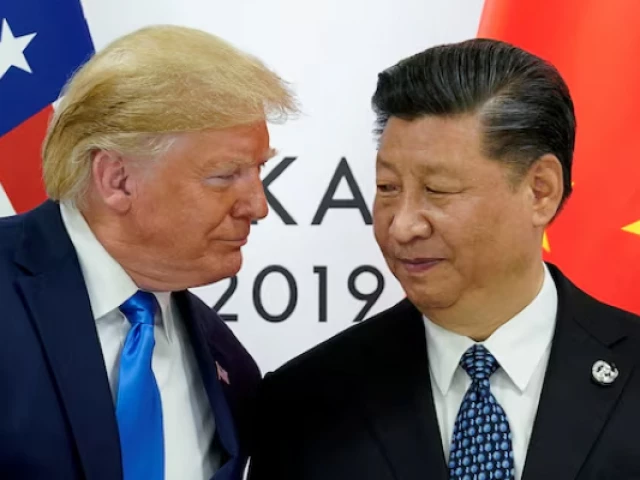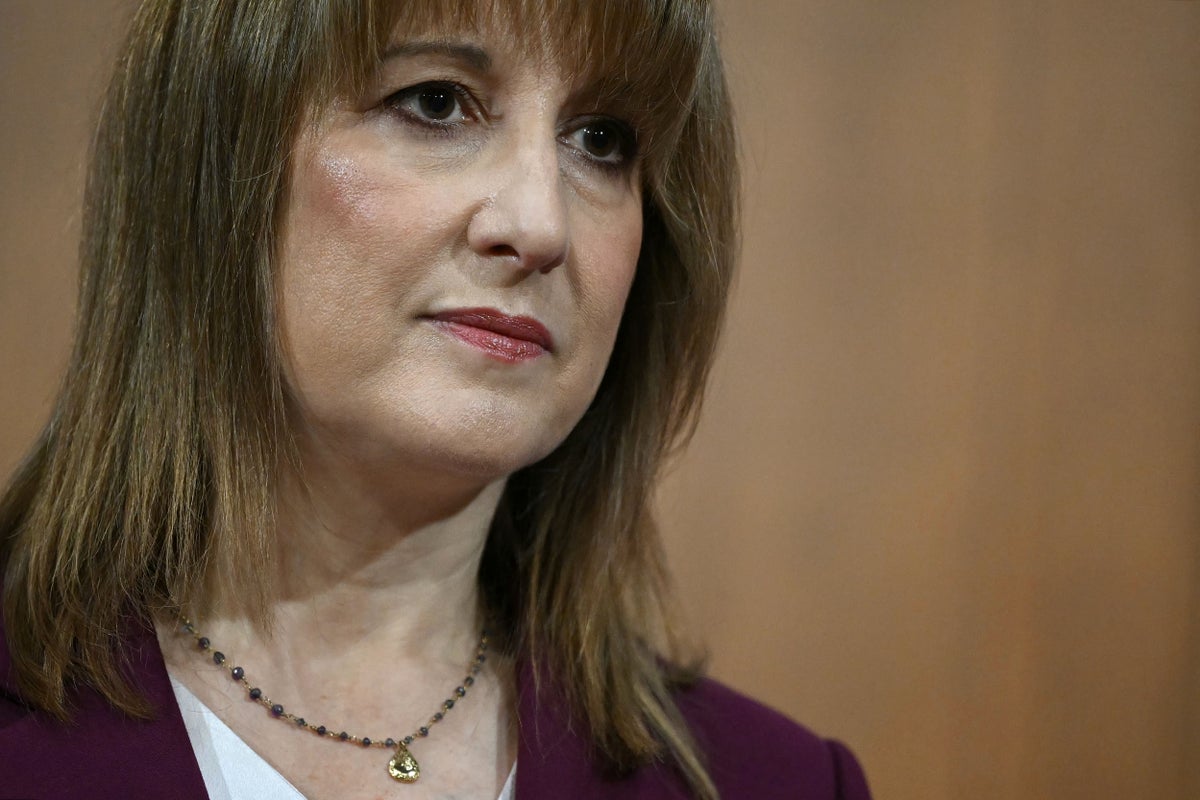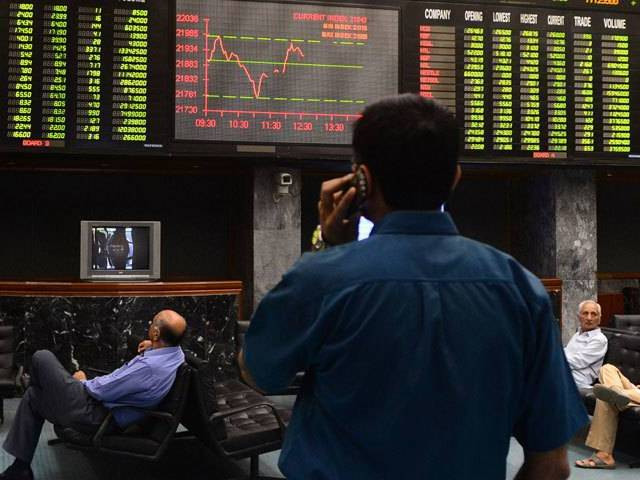Business
Xi-Trump summit call bodes well for global economy | The Express Tribune

KARACHI:
Amid deepening geopolitical fault lines and a fragile global economy, a nearly two-hour-long phone call between Chinese President Xi Jinping and his American counterpart Donald Trump on September 19 produced a rare moment of clarity in the world’s most consequential bilateral relationship.
The phone conversation – described by Beijing as “pragmatic, positive and constructive” and by Washington as “very productive” – signals a mutual willingness to ease tensions.
Just days earlier, top Chinese and US officials concluded their fourth round of talks in Madrid, Spain, where they discussed contentious issues such as Trump’s unilateral tariffs, export controls, the future of TikTok, and potential collaboration on combating money laundering. The key outcome of the two-day discussions was a “framework” deal regarding the Chinese-owned popular video-sharing platform.
The Xi-Trump phone call – the third direct conversation between the two since Trump’s return to the White House in early 2025 – reflects that both sides recognise the importance of leader-to-leader diplomacy in chaotic times. The “candid conversation” the two had covered a wide range of topics, including trade disputes, the TikTok controversy, historical ties, and their shared responsibility to maintain global peace.
The summit call was important both in symbolism and in substance. It came shortly after an impressive military parade China staged to commemorate its victory against Japan in World War II. Xi recalled the China-US wartime alliance and the contributions of American pilots, saying that the families of the “Flying Tigers” were also invited to the parade to honour their sacrifices in China’s “anti-fascist struggle.” The underlying message in Xi’s reference was a subtle call for a renewed commitment to peace and cooperation in today’s turbulent world.
Beijing remains wary of what it sees as an increasingly confrontational posture by the US, driven by Washington’s concern that an “autocratic” China may seek to upend the “liberal democratic world order” and ultimately topple America as the dominant global power. This perceived threat informs much of the US approach – politically, diplomatically, economically, and strategically. This is despite repeated reassurances from the Chinese leadership that the world is “big enough” for both powers to coexist in a mutually respectful and cooperative relationship.
The crux of Xi’s message was conciliatory: the world’s two largest economies, the US and China, are capable of pursuing a symbiotic relationship – provided Washington gives up a zero-sum mindset and both sides commit to working in the same direction towards mutual benefit. At the same time, however, the Chinese leader also reaffirmed his country’s firm stance on major bilateral issues. On trade, he warned against unilateral protectionist measures and stressed the need to build on the progress made in four rounds of negotiations between the two sides.
The latest round of talks was consumed by discussions on TikTok, producing a “framework” agreement that the US later touted as a victory. Xi, however, reiterated that Beijing only supports a resolution that aligns with market principles and Chinese laws while serving the interests of both sides. And this stance is reflected in the unofficially disclosed contours of the deal, which is set to be a joint venture in which ByteDance, TikTok’s parent company, will retain nearly 20% ownership.
Xi also urged Trump to create an “open, fair, and non-discriminatory” environment for Chinese businesses operating in the US, stressing that protectionist policies undermine trust and damage long-term economic interests.
Trump, for his part, struck a similarly conciliatory tone, describing America’s ties with China as “the most important bilateral relationship in the world.” He said Washington desired a “long-term, big and great” relationship with Beijing and acknowledged the importance of collaboration in achieving global peace and stability. Trump also praised the “V Day” parade in Tiananmen Square as “phenomenal and beautiful,” adding a personal touch to the conversation.
It is unrealistic to expect a single call will resolve deep-seated issues, including trade imbalances, technology disputes, and geopolitical rivalries. Any sign of a thaw in their relations is a welcome development, especially against the backdrop of a trade war reignited by Trump after returning to the White House and surrounding himself with “China hawks” in his second administration.
The positive tone between the two leaders resonated far beyond Beijing and Washington. Global markets responded immediately, with major US stock indices, including the Dow Jones Industrial Average, the S&P 500, and the Nasdaq Composite, rallying on renewed optimism about trade stability.
This market confidence reinforces a broader truth: the US-China relationship doesn’t just affect the two superpowers – it impacts the entire world. From international supply chains to climate action, from pandemic preparedness to technology governance, cooperation between the world’s No 1 and No 2 economies is not just important – it is essential.
The World Bank and IMF have consistently warned against US-China economic decoupling, saying it poses huge risks to the global economy as it could disrupt global supply chains, deter international investment, and ultimately hinder economic growth.
A 2021 IMF study found that technological decoupling between the US and China could shrink global GDP by up to 5%. A more recent IMF analysis in 2024 projected that full economic fragmentation could slash global GDP by as much as 7% in the long term – equivalent to $7.4 trillion.
A 2023 World Bank report, however, cautioned that these figures may underestimate the true impact. It warned that the disruption of complex, specialised supply chains could render some critical industries unable to function effectively in a divided global economy.
Any deal on key issues, including US access to rare earth metals and China’s purchase of Russian oil and access to US semiconductor chips, may be unlikely until October when the two leaders will meet face-to-face on the sidelines of a regional summit in South Korea.
The cost of a trade war spiralling between the two economic powerhouses would be immense, particularly at a time when the world is mired in myriad crises, including ongoing wars in Europe and the Middle East, and growing political and economic uncertainty. Washington must reconsider its approach and pivot from confrontation and containment towards cooperation and collaboration – not just for the benefit of the American and Chinese peoples, but for the greater good of the international community.
The key takeaway from the Xi-Trump summit call is a shared realisation in both Beijing and Washington that, despite the strains in their complex relationship, diplomacy – however imperfect – remains the most effective tool for preventing conflict and shaping the global economic outlook.
The writer is an independent journalist with special interest in geoeconomics
Business
DAMAC Properties Unveils Master Development, Launches New Sales Office In Egypt

Last Updated:
DAMAC launched DAMAC Islands 2 and a new Cairo office at the Grand Egyptian Museum, with Hussain Sajwani and Amira Sajwani hosting. Omar Khairat performed.

DAMAC (Representative Image)
DAMAC marked the launch of its new master development DAMAC Islands 2 and its new sales office opening in Egypt with a grand celebration in Egypt at the magnificent Grand Egyptian Museum, an architectural and cultural marvel overlooking the Pyramids of Giza. The glittering evening set against the backdrop of ancient history was hosted by Hussain Sajwani, Founder and Chairman of DAMAC Group, and Amira Sajwani, Managing Director of DAMAC Properties, who welcomed an audience of dignitaries, global investors, media, brokers, and VIP guests from across the world.
Guests at the event were given an exclusive preview of DAMAC Islands 2, the latest luxury community in Dubai, inspired by eight tropical island destinations. The project followed the phenomenal success of DAMAC Islands 1 in 2024, which achieved a record-breaking sell-out. DAMAC sold AED 10 billion in inventory, generating the highest revenue from a real estate launch in 24 hours, as recognised by the Guinness World Records.
The evening’s headline act was legendary Egyptian musician Omar Khairat, who regaled the audience with a captivating fusion of classical, jazz, and traditional Arabic music. Hadi Awada presented a thrilling, choreographed performance.
Hussain Sajwani, Founder of DAMAC Group, said: “This grand celebration and our presence in Cairo represents an affirmation of our deep connection with Egypt. This market has long been one of our most dynamic and promising markets. We’re here to bring DAMAC’s international portfolio closer to Egyptian investors who seek both quality and long-term value.”
Amira Sajwani, Managing Director of DAMAC Properties, noted: “Egyptians already rank among the top ten nationalities purchasing DAMAC homes. We have witnessed double-digit sales growth in this market and expect it to rise another 20% in 2026. Opening our Cairo office also brings us closer to our clients and strengthens the bridge between Cairo and Dubai, the two powerhouses of real estate investment in the MENA region.”
Dubai’s real estate market remains one of the world’s most active and attractive amongst investors and residents alike – with H1 2025 transactions up 40% year-on-year, reinforcing DAMAC’s position at the intersection of two of the region’s most vibrant markets. Furthermore, DAMAC communities continue to lead market performance, with DAMAC Islands recording 4,185 villa and townhouse sales in H1 2025 and DAMAC Hills 2 registering 1,942 sales.
On average from launch, price growth at DAMAC Hills 1 townhouses rose 86 per cent, DAMAC Hills 1 villas 72 per cent, DAMAC Hills 2 townhouses 60 per cent, and DAMAC Islands villas 29 per cent, demonstrating sustained investor confidence in the brand’s long-term value.
DAMAC Islands 2 brings the rhythm of the tropics to the heart of Dubai; blending lush landscapes, crystal lagoons, and wellness-driven design inspired by eight dream destinations: Antigua, Bahamas, Barbados, Bermuda, Cuba, Maui, Mauritius, and Tahiti. As part of the launch campaign for DAMAC Islands 2, DAMAC also launched a unique global competition to become ‘The Ultimate Islander’.
The competition winner will receive an all-expenses-paid trip and become an employee of DAMAC while living on one of their eight islands. The master-planned project will comprise six-bedroom luxury villas of approximately 583 square meters, five-bedroom twin villas of approximately 324 square meters, five-bedroom townhouses of approximately 293 and 263 square meters, and four-bedroom townhouses of approximately 203 square meters. Prices start at AED 2.7 million.
A team of writers and reporters decodes vast terms of personal finance and making money matters simpler for you. From latest initial public offerings (IPOs) in the market to best investment options, we cover al…Read More
A team of writers and reporters decodes vast terms of personal finance and making money matters simpler for you. From latest initial public offerings (IPOs) in the market to best investment options, we cover al… Read More
November 15, 2025, 13:25 IST
Read More
Business
Gold Loan Tips: 3 Repayment Tricks That Can Save You A Fortune

Last Updated:
Three repayment choices, one crucial decision — and the difference could cost you lakhs. Pick wisely, and a gold loan becomes far lighter on both your mind and your pocket
Selecting the right gold loan repayment method can save you money. (AI Generated)
Gold loans may be easy to take, but they are not always easy to repay, and a small mistake can cost borrowers thousands, even lakhs, in extra interest. Most people focus only on the 9-10 per cent interest rate, unaware that the real cost depends entirely on the repayment method they choose.
One wrong decision can make a cheap loan expensive; the right one can make it far more affordable.
According to an Economic Times report, Jijith Raj, Business Head at Indel Money, has explained three loan repayment methods and who each of them is best suited for.
1. Regular EMI
In this method, you pay a fixed instalment every month, which includes both principal and interest. As the months pass, the principal reduces, and the total interest you pay is the lowest among the three options.
This method is ideal for people who earn a regular monthly income like salaried employees, pensioners, or those receiving steady rental income. Setting up an auto-debit ensures discipline.
However, if you miss even a single EMI, the bank may quickly classify your account as an SMA and report it to the credit bureau, which can lower your CIBIL score.
2. Bullet Repayment
This is the option most people prefer because it gives them the highest level of flexibility. You may pay nothing or only the interest during the loan period, and then clear the entire principal and remaining interest in one go on the final day. This method works well if you are certain that you will receive a large sum within 6-12 months, such as from selling property, an FD maturing, or a sizeable business payment.
But the risk is high: if you are unable to arrange the lump sum by the due date, the interest balloons because the full principal remains unpaid.
Moreover, 45 days after the loan period ends, the bank can begin the process of auctioning your gold, which catches many borrowers off-guard.
3. Overdraft Facility
This option may appear slightly more expensive upfront, but it is perfect for those with irregular income like freelancers, small shop owners, agents who work on commission, consultants, and similar professions.
The bank sanctions a limit (for example, Rs 10 lakh), and you pay interest only on the amount you actually withdraw, not on the entire limit. When you receive money, you can deposit it back instantly, and your interest reduces immediately. You can withdraw and deposit as many times as you wish.
If you need a top-up, it is usually granted without closing the existing loan. Although the interest rate might be a bit higher, the overall cost remains low because your outstanding balance typically stays small.
Which Method Saves The Most?
- If your income is steady, choose EMI as it results in the lowest interest outflow.
- If you are expecting a lump sum, bullet repayment can work but it is risky.
- If your income is irregular, opt for the overdraft facility, which keeps your interest under control.
A crucial tip: If you have chosen the wrong repayment scheme earlier and a major portion of your loan tenure still remains, close the old loan and take a new loan against the same gold under a better scheme.
Most companies do not charge foreclosure fees, but always confirm this before proceeding.
November 15, 2025, 11:42 IST
Read More
Business
Tata Motors Demerger Complete: Selling Shares now? Tax Expert Warns Of CV-Gain, PV-Loss Twist

Last Updated:
Tata Motors completed its demerger, listing Tata Motors Ltd for commercial vehicles. Shareholders get tax-neutral shares, with gains taxed only on sale.

Tata Motors Demerger
Tata Motors Demerger: Tata Motors Limited, the commercial arm of the automobile, has begun trading on November 12. Shares of Tata Motors Commercial Vehicles Ltd (TMCVL) made their stock market debut at Rs 335 apiece on NSE, a premium of 28.48% to its implied value of Rs 260.75 per share. Shares dropped to end at Rs 317.60 apiece.
The listing follows the Tata Motors demerger, which officially came into effect on October 1, 2025. Under the plan, shareholders received one share of Tata Motors Commercial Vehicles Ltd for every share held in Tata Motors as of the record date, October 14, 2025.
Post-restructuring, the Commercial Vehicles (CV) business has been renamed Tata Motors, while the Passenger Vehicles (PV), Electric Vehicles (EVs), and Jaguar Land Rover (JLR) businesses now operate under Tata Motors Passenger Vehicles Ltd (TMPV), which is already listed as a separate entity.
The good news is that receiving these new shares is not taxable. Since the split took place under a court-approved demerger, Section 47 of the Income Tax Act treats this as “tax neutral”, meaning there is no transfer and no tax is triggered at the time of allotment.
What Happens If You Sell These Shares?
But, investors must know that these shares will be taxable if you sell them.
Sujit Bangar, the founder of taxbuddy.com, has explained the demerger taxation in his X post.
Tata Motors has officially declared the cost allocation ratio for the two new entities:
- 31.15% of your original cost goes to the CV company
- 68.85% goes to the PV company
This split must be followed exactly while calculating capital gains.
For example, an investor who originally bought 1,000 Tata Motors shares at Rs 660 each had a total cost of Rs 6,60,000. After applying the official ratio, the revised cost becomes:
- TMCV: Rs 2,05,590
- TMPV: Rs 4,54,410
If these shares are sold at the current market prices—Rs 318 for Tata Motors and Rs 391 for Tata Motors Passenger Vehicle—the investor ends up with:
- Gain of Rs 1,12,410 on the CV company
- Loss of Rs 63,410 on the PV company
- Net long-term gain: Rs 49,000
Tata Motors has 66,55,766 shareholdersThey’ve completed a demerger and recently declared the cost of both companies
Before you rush to sell, you may have gains in the CV entity but a loss in the PV entity.
Here’s all that you need to know about your demerger taxation 👇🧵 pic.twitter.com/7fkCN8SQUs
— Sujit Bangar (@sujit_bangar) November 14, 2025
The original holding period of Tata Motors carries forward for both companies. This decides whether the gain is short-term or long-term.

Varun Yadav is a Sub Editor at News18 Business Digital. He writes articles on markets, personal finance, technology, and more. He completed his post-graduation diploma in English Journalism from the Indian Inst…Read More
Varun Yadav is a Sub Editor at News18 Business Digital. He writes articles on markets, personal finance, technology, and more. He completed his post-graduation diploma in English Journalism from the Indian Inst… Read More
November 15, 2025, 10:40 IST
Read More
-

 Entertainment1 week ago
Entertainment1 week agoChina unveils£5.4 bn Fujian, its most advanced aircraft carrier yet
-

 Politics1 week ago
Politics1 week agoIDF lawyers warned of possible Gaza war crimes: US intel findings
-

 Entertainment1 week ago
Entertainment1 week agoRobert Pattinson jokes about competing with Gen Z
-

 Tech1 week ago
Tech1 week ago‘Vibe coding’ named word of the year by Collins dictionary
-

 Business1 week ago
Business1 week agoBudget tax hikes could see food prices soar, major supermarket boss warns
-

 Business1 week ago
Business1 week agoFM asks banks to ensure staff speak local language – The Times of India
-

 Sports1 week ago
Sports1 week agoWho’s the striker beating Mbappé, Haaland in race for European Golden Shoe?
-

 Tech1 week ago
Tech1 week agoWhy fears of a trillion-dollar AI bubble are growing












